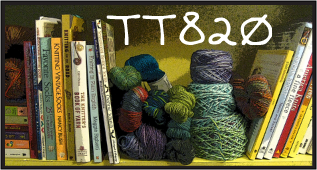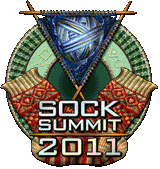In addition to the super fun and useful class on blending boards that I took at (virtual) MDSW this year, I also took two classes from Judith MacKenzie: one on spinning tweed yarns, and one on spinning the Columbia breed.
The timing ended up not being great for me. The classes were both 7-9 pm, and the Tweed class fell on the day after my second COVID vaccine shot. I was not feeling well and my brain was definitely not operating at 100%. Fortunately, the class was recorded and I can re-watch it! I can tell I wasn't feeling well because I took no photos during the class (very unusual for me). But here is the class kit that arrived in the mail beforehand. What a wonderful collection of fibers to play with!
Tweed is yarn made from leftover and recycled fibers, and that is what some of this material is. If you look closely, you'll see a bag of yarn snippets, a bag of woven fabric strips, and a bag with pieces of a cashmere sweater in it (one piece is unraveled so it looks like ramen). Tweed fabric is named after the River Tweed, on which the mill that wove this fabric was located.
The bag of fiber on the left side of the photo is Judith's own tweed roving, made from alpaca, Shetland, and silk waste. She has this carded specifically for handspinning. I can't wait to dive into it.
During the class, we endeavored to card our own blends for spinning tweed. Judith (or "Mother MacKenzie," as I think of her often) recommended using an old, battered, pair of handcards that can really take a beating. But I don't have an old pair of handcards - I only have the one pair, which I don't want to mess up. My carded preps didn't spin terribly well. Here are the samples I spun during class:
I really love the idea of tweedy yarn made with leftover bits. In fact, that is essentially what I bought to make my Greynbow yarn with many years ago ... the mill that carded it couldn't even tell me what was in it, because it was recycled leftovers. But I think if I am going to make more tweed yarns, I might do best with a drum carder (which I don't own). Perhaps I can experiment with the blending board.
The next evening, I had the class on spinning Columbia, which is the first American sheep breed. It's a cross between Rambouillet (a fine wool) and Lincoln (a long wool with great luster), and it really is lovely. Here is the kit that arrived for this class:
This fiber is all from the same fleece... and so was the fiber that all my classmates received. Columbia fleeces can be large (Judith said this one was about 15 pounds) and she still had more to spare! The fluffy roll on the left is a small batt (carded prep). In the middle is a collection of cleaned locks - these were folded and rolled in a bit of fabric in order to preserve the lock structure. The bag at the top right is raw fiber which I need to wash (note how dark it is compared to the clean fiber). And the small bag on the bottom right is silk, for blending.During the class, I worked with the clean locks in the middle. I flicked them with my flick carder to prepare them for spinning. This is a classic worsted prep, and I planned to spin the locks with a worsted style (short forward draft)... so I took care to keep the tips facing the same direction so I could spin from the tips. Here you can see a lock before and after flicking:
I acquired another new tool last week: a hairbrush cleaner. This was recommended as the best way to clean stray fibers out of the blending board, and as it was easily obtainable online, I ordered it. I LOVE THIS THING. It is so easy to get the waste fiber out of anything with carding cloth on it, including my flick carder!I also cleaned my hairbrush.I spun all those beautiful locks, and made this small skein of 2-ply yarn. It's so white and shiny - the Lincoln part of the breed really comes through:
Judith says there are "lots of dye sites" on Columbia, and the bright, blue-white color indicates this. I haven't heard anyone talk about dye sites before, but if Mother MacKenzie says it, then it's true.
I really enjoyed flicking and spinning this skein. Alternating between flicking and spinning strikes me as an excellent way to avoid repetitive stress injuries. And it's fun. I could see doing a big spin this way, with the right fleece!
The students in this class crowd-sourced a list of our favorite places to buy fleeces. Of course, the BEST place to buy fleeces is the MDSW Fleece Barn (Judith said it took her breath away the first time she saw it), but that's not always possible. I'll share the list here in case it's helpful to anyone else:
- Maryland Sheep Breeders Association - check their directory
- Individual Breed registry/associations - they will list fleece sellers
- Shepherd's Hey Farm, MD- Lee Langstaff - this is where I got my first fleeces - you cannot go wrong with a Shepherd's Hey fleece - Jillian Moreno agrees!
- Ruppert's Corriedales
- Peggy Howell, MD
- Kate Bostek, Roclans Farm, PA
- Solitude Farm, Roundhill VA – Gretchen Frederick
- Steitzhof Merino, Genopalette in MO.
- Fiber First Farm, Washington State – Romeldale, Corriedale and some other crosses
- Nistock farm in NY.
- Sheep show winners lists!
- Black Sheep Gathering, Oregon. Small but excellent quality!
- At MDSW the Fleece Show winners for the current year are always posted at the front of the Fleece Show and Sale Barn near the silent auction prize winning fleeces
- Alice Field, Foxhill Farm in Lee Mass has outstanding Cormo
I really miss attending this festival in person, but I'm glad I got to take these classes. Next year is going to be a blowout festival. I can't wait.












Another sad year without MDSW, but I am glad you got to take several great classes. That white skein is visually stunning to me (and there is the bonus of having a clean hairbrush with a new multipurpose tool). I look forward to maybe seeing more blending, tweed, and Columbia.
ReplyDeleteIt was so awesome to be in Virtual Class with you! You asked great questions! Thank you :)
ReplyDelete